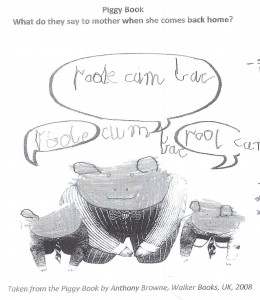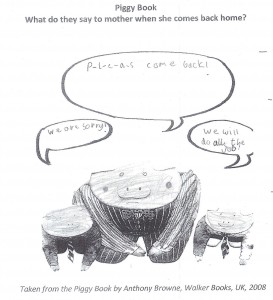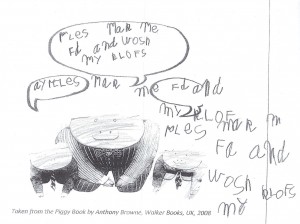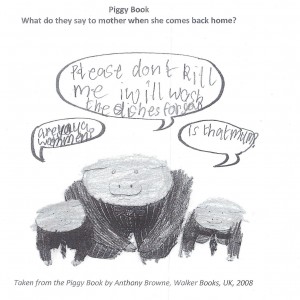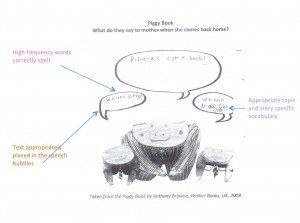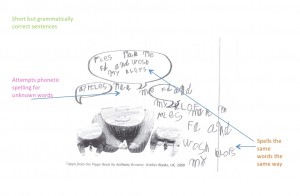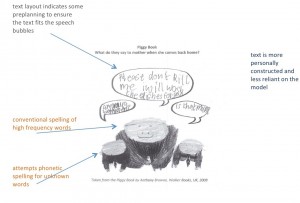3. Story book captions
Please click on the toggles below to navigate through information on this assessment task and reveal the links for downloading task materials.
Task details |
|
| Name of writing assessment task | Story book captions |
| EAL curriculum level range | A1, A2, BL, B1, B2, CL, C1, C2 |
| Text orientation | Imaginative |
| Task type | Cued response |
Task specification |
|
| Purpose | To assess students' ability to create character speech from a narrative. |
| Description | Students complete the speech bubbles to record an imaginative dialogue between two or three characters from a well-known story. |
| Assumed knowledge and description |
|
Learning/teaching context |
|
| Language centre/mainstream class | Mainstream class – EAL |
| Subject/key curriculum objectives, outcomes | English |
| Topic/teaching unit | |
| Assessment conditions |
|
| Notes |
|
Task implementation |
|
| STAGE | ACTION STEPS |
| Pre-assessment activity |
|
| Assessment activity |
|
| Post-assessment activity |
|
- TEAL Writing Task 3 -unmarked criteria sheet [PDF]
- TEAL Writing Task 3- unmarked criteria sheet [Word]
An explanation of the purpose, nature and use of criteria sheets is available at 4. Using the assessment criteria.
Purpose and value of task
This task assesses students’ ability to write imaginative dialogue that relates to a story they are familiar with, using their own words. The task gives teachers the opportunity to watch students as they write and to observe the strategies and resources they use to construct their texts. This kind of task is common classroom task, where students listen to stories and then do a range of early reading and writing tasks based on them. The task may be suitable for younger students at CL and C1 as long as the chosen text is age appropriate.
Contextual information
The samples came from one classroom which had students at Stages A1 and A2. The students were familiar with the story from listening to it several times, and talking about what happened in the story. They undertook a range of activities including ‘freeze framing’ where the students created tableaux of scenes from the story, and then said what they though the characters were saying at the time.
Commentary
It is clear from the samples that the students are still at early stages of writing in English. They all understand the need to write dialogue in the bubbles, but their ability to do this is variable. Some students do little more than reproduce the text from the story (including the spelling of please in the story as P-L-E-A-S-E) but others were able to write their own text, which included the tasks the characters did after Mrs Piggott returned. Students seemed to have different interpretations of the story. Some students seemed to misunderstand the moral, and had the characters demanding that Mrs Piggott resume her old habits of doing all the work. While most students seemed to understand that the father and children had had a change of heart and now understood that it was fair that they undertook some of the household tasks, others decided that the mother had now become the tyrant. One student wrote, Please don’t kill me I will wash the dishes for you. With students at early stages of English language development it may not be possible to have an in-depth discussion around the behaviour, motivations or morals (including gender roles), which are the focus of this story. A discussion using a teacher aide can help students to think about these issues.
The students employ a range of strategies to write their texts, including attempts at spelling using their developing understanding of the sound symbol relationships of English. Some students seem to prefer to attempt spelling words their own way, while others seek out other strategies such as memorising or copying words. Their basic oral English language stage will also affect what they are able to write, and some students were able to express more sophisticated ideas than others.
Sample 1
Commentary
The student’s response shows an understanding of the task and the need to write speech. The student has reproduced the words of the text, attempting to write Please come back, but with novel spellings. The spelling of please does not follow plausible English sound-letter relationships, except for the first letter. The attempts at come and back show a stronger understanding of sound-letter relationships.
The handwriting is emergent — although most letters are formed correctly, the letter ‘m’ is not always written the same way, and the letter ‘p’ does not ‘sit on the line’. The student has not confined the writing to the speech bubbles, but may not yet be able to write small enough to do this. Only lower case letters are used, with no punctuation.
The marked criteria sheet shows that the student meets most criteria at level 1 of performance.
The student’s language use in this task is consistent with the descriptions of students at Level A1, Victorian Curriculum F-10 EAL.
TEAL Writing Task 3 – criteria sheet – Sample 1
Using this assessment for further learning
After asking the student to reread the text, ask for further information, and scribe this, expanding on what the student has said. For example the student may be able to answer the question, ‘Why do you think mum went away?’
The student can then be asked to copy the new dialogue onto a fresh sheet. Add the first draft and copied correct sentences to the student’s portfolio.
Choose two or three high-frequency words to add to the student’s dictionary or to a wall chart. The student can illustrate the words.
Sample 2
This student has also reproduced the words of the text in the main speech bubble, but with more conventional layout and spelling. He or she has also added their own words to the small bubbles, which indicate a conventional understanding of the text, that the pigs have learnt their lesson.
The handwriting is appropriately sized to fit into the speech bubbles, and letters are mostly correctly formed. Although it is not always clear if a letter is upper or lower case.
The spelling of high frequency words, we will, we are, is correct. The student has copied the layout of the book in the way that please is written. Exclamation marks have been added to the end of each sentence, even though exclamation marks are not prominent in the book itself. This shows the student is learning the appropriate placement of an exclamation mark. Capital letters are used at the start of the sentences
The marked criteria sheet shows that the student meets most criteria at level 2 of performance, with a higher level in writing conventions.
The student’s language use in this task is consistent with the descriptions of students at Level A1, Victorian Curriculum F-10 EAL.
TEAL Writing Task 3 – criteria sheet – Sample 2
Using this assessment for further learning
Give the student further opportunities to write his/her own dialogue for other parts of the story. The text can be used for a short role-play with other students.
Once they have finished the role-play, ask the students if they can improve on the dialogue, and encourage them to rewrite the text to be more interesting.
Choose two or three high-frequency words to add to the student’s dictionary or to a wall chart. The student can illustrate the words.
Sample 3
This student has not followed the original story, but has written his or her own take on the text, with all three pigs entreating mum, Please make me food and wash my clothes. The student may not have fully understood the text, or why the pigs reformed their ways and ended up doing their own cooking and cleaning.
The writing conventions are not as advanced as the other two samples, but the student makes plausible attempts at spelling. The high frequency words and, me and my are spelled correctly. Handwriting is large and there are issues with letter formation, use of upper and lower case letters and positioning of the letters on the page. Because the student’s writing is large, it does not fit into the speech bubbles.
The marked criteria sheet shows that the student meets criteria from levels 2 to 4 of performance, with a lower level in writing conventions.
The student’s language use in this task is consistent with the descriptions of students at Level A1, Victorian Curriculum F-10 EAL.
TEAL Writing Task 3 – criteria sheet – Sample 3
Using this assessment for further learning
After asking the student to reread the text, ask for further information, and scribe this, expanding on what the student has said. For example, the student may be able to answer the question, ‘Why do you think mum went away?’
The student can then be asked to copy the new dialogue onto a fresh sheet. Add the first draft and copied correct sentences to the student’s portfolio.
Choose two or three words the student has misspelt and look at them in the text. For example show the student how klofs is spelt clothes in the text. Discuss how the both ‘c’ and ‘k’ can represent the same sound. Help the student to make a short list of known words that start with both ‘c’ and ‘k’. The student can illustrate the words.
Sample 4
This student too has written his/her own interpretation of the story, perhaps interpreting the mother’s actions as aggressive, writing, Please don’t kill me I will wash the dishes for you. The two little pigs ask, Are you a woman? and Is that mum? The English used is more sophisticated in its grammar and ideas then earlier samples.
Correct spelling is used except for woommen, and i. The writing is neat with correct formation and contained within the speech bubbles. The two questions don’t start with an upper case letter, but question marks are used.
The marked criteria sheet shows that the student meets across criteria across levels 1 to 3 of performance.
The student’s language use in this task is consistent with the descriptions of students at Level A2, Victorian Curriculum F-10 EAL.
TEAL Writing Task 3 – criteria sheet – Sample 4
Using this assessment for further learning
Discuss with the student why he/she thinks that the father is frightened. Talk about alternative interpretations, such as he might be sad and sorry.
Ask the student to write dialogue for the alternative ending. The two different interpretations can be role played with other students.
Add the first draft and alternative sentences to the student’s portfolio.
Point out that i is always spelt with an uppercase letter, and that questions start with an upper case letter. Ask the student how they worked out how to spell ‘woman’. Correct the student’s spelling, pointing out how close the attempt was to being correct.

